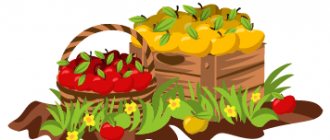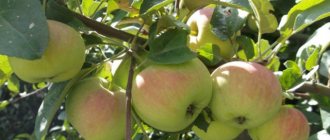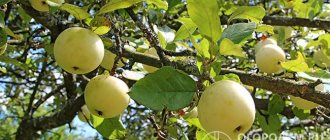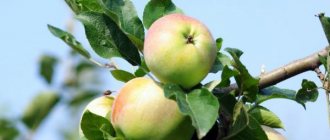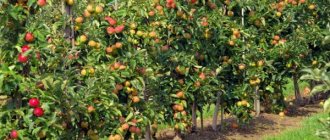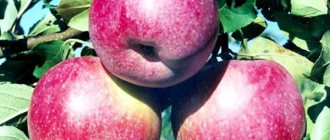Apples not only have a pleasant taste and an unforgettable, incomparable aroma, but also amazing properties that are actively used in modern dietetics.
They are included in the diet of people who need to lose weight due to their high fiber content and organic acids.
The chlorogenic acid contained in them helps cleanse the liver, remove toxins from the body, and normalize the functioning of the digestive system. Therefore, if you are asking whether it is worth planting apple trees on your property, we say a resounding Yes!
To choose the right apple tree variety, you need to understand the growing conditions and what kind of care you are willing to provide it. The features of the Auxis variety, its requirements, advantages and disadvantages are described in our article. This knowledge will help you decide whether this apple tree is right for you and whether it is worth planting it on your site.
Description, photo
This apple tree with the sonorous and memorable name Auxis is the result of the work of Lithuanian breeders.
Crossing Grafenstein Red and McIntosh gave a good result: a variety was developed that took the excellent qualities of its parents and some of their shortcomings.
Auxis is zoned not only in Lithuania, but also in some European countries where a temperate continental or northern climate prevails.
Advantages and disadvantages
Auxis has a number of important features that can be called the advantages of the variety:
- Excellent winter hardiness;
- High quality yield indicators;
- Rapid entry into fruiting season.
obvious shortcomings of the variety ; it is worth noting only the high shedding of fruits , which can cause mechanical damage to the crop.
Tree morphology
Apple trees can be classified as medium-sized, the height can vary between 4.5 - 5 m , the crown is neat, quite compact, spherical. The leaves are green, medium-sized, matte, calm green.
Apple tree Auxis 3 year old.
The flowers are white, with a very slight pink tint.
The fruits are formed on almost all shoots, have the regular outline of a ball, slightly flattened at the apex, and can reach a weight of 170 g. The peel is smooth, medium in density, with a light waxy coating.
The color of the main part is green with a slight yellowish tint, on which bright red strokes are visible along the entire perimeter . The pulp is yellowish, very juicy and aromatic, dense, with a pleasant texture and amazing dessert taste.
Yield and tasting rating
The variety is characterized by high yield , but over the years a partial periodicity of fruiting can be observed, which occurs under certain weather conditions.
The main advantage of Auxis is the amazing taste of the fruit; the sweetness of the apples is diluted by a light fresh sourness, for which it received a high score during the tasting.
Winter hardiness and disease resistance
In the conditions of the Middle Zone, the variety shows an average level of resistance to frost ; during snowless winters, it is best to cover the trunk to avoid freezing and cracking of the bark.
The apple tree variety Auxis is quite resistant to scab and shows good resistance to other diseases .
Important! Disease resistance only works if the tree receives the full range of necessary agrotechnical care measures.
See what the Auxis apple tree looks like in the video below:
Advantages and disadvantages of the variety
- The advantages include:
- frost resistance;
- high productivity;
- average early pregnancy (5 years from planting);
- high taste indicators.
- Flaws:
- irregular fruiting;
- demands on soil composition;
- crumbles quickly, it is necessary to collect before the fruits have time to fully ripen;
- poor resistance to scab and pests;
- does not pollinate on its own.
Reviews
Anatoly, Kolomna. “Very cool variety! The most delicious apples I've ever tasted! There are several problems in growing: firstly, they fall off very quickly, it is difficult to catch the moment when to remove them without losing the harvest. And there were problems with wintering - the seedling was partially frozen, but they nursed it, cast it, revived it and then tried to protect it.”
Stanislav, Tula region. “I’ve been planning to plant it for a long time, I kept reading photos and descriptions of the variety on the Internet, but three years ago I finally got around to it. The seedling is on a dwarf rootstock, which means it should produce its first fruits this year, so I can’t wait to take a sample! After all, the deliciousness is simply indescribable!”
Alla, Penza. “My parents have this apple tree, I love it very much! Delicious, beautiful apples, they lie great in the cellar, we eat them until the end of winter, maybe longer - we’re just running out of them, we’re all such apple lovers! I recommend it to everyone who is partial to this fruit! A capricious tree, but the result is worth it!”
Collection and storage
Harvest 2 weeks before full ripening. The procedure is carried out at the end of August. Apples are green in color and have a deep crimson blush at this time. The fruits are carefully removed from the trees, preventing them from falling. If the harvest is not carried out in a timely manner, the fruits fall off.
Store the harvest in a cool place, for example, in a cellar or on a balcony. Apples are laid out in plastic or wooden boxes in one row. Periodically inspect the fruits, remove spoiled and rotten ones.
Auxis fruits have a dense structure, so they store well
Features of planting and care
Dates and methods of planting
Planting a seedling can be done in the fall (September) so that it can take root before the onset of frost. Or in the spring, in April , when the threat of return frosts has passed.
For planting, it is best to choose sunny areas with normal groundwater.
Before planting, prepare a hole for the seedling with a depth of 70 - 80 cm, a diameter of 100 cm, remove the top layer of soil, mix it with humus. A peg and a seedling are placed in the middle of the hole, carefully covered with the soil mixture made earlier, and spilled with water.
You can make a small roll of soil along the outer perimeter of the hole to retain moisture.
Watch the video on how to plant an apple tree:
Agricultural technology
Agricultural technology includes several main activities:
- Watering;
- Feeding;
- Loosening;
- Weed removal
Watering is carried out in the root zone from spring to autumn, starting from the budding stage, adjusted for weather conditions. The amount of watering depends on the age of the tree; for an adult apple tree - 15 liters of water once a week.
Watering the apple tree is carried out in the root zone.
Organic fertilizers are applied in the fall before winter, slightly deepening them, mineral fertilizers - starting in spring:
- Nitrogen-containing on thawed-frozen soil;
- Phosphorus-potassium - according to the scheme, starting from the budding period with a frequency of three weeks until the start of ripening.
If necessary, you can also fertilize with microelements by spraying on the green mass.
Advice! For preventive control of diseases and pests, it is advisable to introduce periodic spraying of Fufanon, Inta-Vir, and copper sulfate into agricultural technology. To increase the vitality of the tree and its immunity, drugs such as Zircon and Epin will be indispensable.
Caring for the tree trunk includes timely removal of weeds and loosening of the top layer of soil to improve moisture and air exchange. Loosening is carried out the next day after watering.
Pruning and crown formation
Pruning is carried out in autumn and spring:
- In autumn , it is necessary to remove damaged and weak shoots, which can become a hotbed for the spread of fungal and bacterial diseases in winter;
- In the spring, formative pruning is carried out . You need to start approximately 3–4 years after planting the apple tree. Remove: Old obsolete branches;
- Shoots that were damaged during wintering by snow drifts;
- Branches growing inside the crown.
Watch the video on how spring pruning is carried out:
And a video on how to prune an apple tree in the fall:
Pollinator varieties
Auxis is not self-pollinating , so it needs to be planted as a pollinator tree , which can be any variety with a mid-winter ripening period.
Growing difficulties
The difficulty is due to the fact that Auxis apples are prone to various diseases: scab, powdery mildew, fungus. They can also easily succumb to the influence of apple mites and codling moths, caterpillars and hawthorn. It is necessary to carry out preventive pest control measures periodically.
To do this, in the spring, a solution of urea and other chemical impurities are used, which are sprayed on the crown and trunk of trees.
Fungi of various origins are destroyed with a copper-soap solution, and powdery mildew with sulfur-lime, but first get rid of the infected areas and set them on fire.
Features of ripening and fruiting
Beginning of fruiting
The period of entry of the Auxis apple tree depends on the rootstock it is grown on:
- The seed rootstock begins to bear fruit around the fifth year of life;
- On dwarf rootstocks , of course, earlier, approximately in the third year after planting.
Auxis begins to bear fruit in the fifth year.
Deadlines
Flowering and fruit ripening
The tree blooms in late spring , covered with fragrant white and pink flowers. The fruits begin to ripen at the end of September.
Attention! It is very important to choose the moment to collect them, without missing the moment when the apples begin to fall en masse.
Fruit storage
The fruits can be stored almost until February, and in a refrigerator - until March , without loss of taste and presentation.
Auxis fruits can be stored until March.
Periodicity
There is no obvious periodicity in the fruiting of this variety. The harvest can be obtained every year in an average volume. The only option in which this may not happen is extreme weather conditions that are not typical for the areas where it grows.
Description and characteristics of the Auxis apple tree
Auxis was obtained by crossing varieties such as Mackintosh and Grafenstein red. The tree is medium in height, up to 4 m, but in some cases it can reach 6 m. The crown is small, round in shape, and of medium density. Blooms at the end of May. The type of pollination is cross. The fruits are round or turnip-shaped. On average, the weight of the fetus is 110 g, but sometimes the weight of the fruit can reach 180 g.
Did you know? More than 7,500 varieties of apples are grown around the world.
The thickness of the peel is medium and has a waxy coating. The color of apples ranges from green-yellow to light yellow with a red blush. The texture of the pulp is dense and juicy. The ripening period is late September - early October. With timely collection and proper storage, it has high shelf life until the end of February.
Cultivation in selected areas
In areas with a more severe climate, its cultivation is possible provided that it is cultivated on frost-resistant rootstocks , however, the lack of a sufficient number of sunny days can negatively affect the quality of the fruit by not providing the required amount of sugars.
In the Leningrad region, you should carefully monitor the occurrence of groundwater when choosing a planting site. It is imperative to build a drainage that will be able to protect them from getting wet.
When growing Auxis in the Leningrad region, you should carefully monitor the occurrence of groundwater.
In the Middle and Central regions of Russia, the variety is zoned and approved for cultivation. But average winter hardiness requires that the tree be carefully prepared for wintering, and be sure to mulch the soil so that the part of the root system located in the upper layers of the soil is more protected.
Advantages and disadvantages
The Auxis apple tree has its advantages:
- high productivity;
- mid-ripening;
- high taste qualities;
- transportability;
- keeping quality;
- frost resistance;
- strong immunity.
Among the shortcomings, the tree is whimsical to favorable growing conditions. If you do not feed, overwater or overdry the plant, it will immediately let you know.
It is necessary to monitor the condition of the tree to get a high yield
How to plant an apple tree
To enjoy juicy, healthy fruits, you have to make a little effort. Growing and caring for apple trees is not particularly difficult, but the key to a rich harvest lies in proper planting of the crop.
Selection of seedlings
Fruit tree seedlings can often be found at markets or fairs, and sometimes they are sold from parked cars. Experienced gardeners warn beginners against purchasing apple trees in such places. The planting material may turn out to be of a completely different variety, not to mention diseases and pests, because it is unknown in what conditions the tiny tree grew.
The best option is to go shopping for an apple tree at a local fruit nursery. The staff of the institution will help you choose a suitable tree and tell you the secrets of cultivation. The risk of purchasing low-quality planting material is minimal, because the health of the seedlings in the nursery is carefully monitored.
The rooting process of specimens 2 years old proceeds quickly. Such plants have a pronounced conductor and 2-3 shoots
Pay attention to inspecting the branches and root lobe. A healthy apple tree has well-developed elastic roots and flexible branches.
There should be no damage, growths, traces of pest activity, or visible foci of disease on the bark and roots.
Before planting, the root system is dipped in a weak solution of potassium permanganate for 2-3 hours, and then dipped in clay mash. Roots that are too long are shortened and damaged ones are cut off.
When to plant an apple tree, choosing a planting location
It is customary to plant fruit trees in early spring or autumn. Spring planting is preferable for regions with unfavorable climatic conditions. Over the course of the season, the tree will get stronger and have time to fully prepare for wintering. In autumn, fruit trees are planted in the South. Spring here is short and swift, and autumn is favorable for the development of the root system.
In the spring, planting work is carried out from mid-April to the end of the first ten days of May, and in the fall in early October.
The site for the tree is selected depending on the size and the need for pollinators. According to the description, the Auxis apple tree is a rather large tree; it and its pollinating neighbors will need a lot of space.
The place should be well lit throughout the day. For protection from the wind, choose an area located 4-5 meters from a natural or artificial barrier (building, fence). The roots of the apple tree do not tolerate waterlogging, so before choosing a site, determine the groundwater level. Minimum – 2.5-3 m from the ground surface.
Landing technology
The site is prepared for planting the Auxis apple tree in advance. For spring planting in the fall, and for autumn planting 6-8 weeks before the event. In uncultivated areas, the soil composition is improved by adding sand and organic fertilizers (compost, humus) for digging.
Landing instructions:
- prepare a hole with a depth and diameter of 80-100 cm. The step between holes is 4.5-5 m;
- fill a third of the pit with a nutrient substrate based on the removed soil and 2-3 buckets of rotted organic matter. Enrich the soil mixture with wood ash (500 g), add 150 g of the complete mineral complex;
- form a hill out of the ground, drive a support into the center of the hole. Place the seedling on a raised platform, straighten the roots;
- Gradually fill the pit with soil, avoiding the formation of voids. Form a circle around the trunk, water the tree generously with warm water;
- spread mulch on the soil and tie the seedling to a support.
Do not allow the root collar to go deep. The level of location is 4-7 cm above the surface of the hole.
